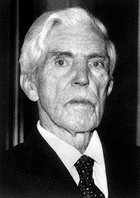| Profile | Major Works | Resources |
Trygve Haavelmo, 1911-1999

The Norwegian economist Trygve Haavelmo began his career as a student of Ragnar Frisch at University of Oslo. He went to the United States in 1939 as a Fulbright scholar, where he ended up staying until 1947. Haavelmo spent much of his sojourn at the Cowles Commission, before returning to Oslo. He remained a professor a the University of Oslo until his retirement.
It was during his stay in the United States that Haavelmo wrote his most influential work -- a 1944 article introducing the "probability approach" to econometrics. The "probability" approach argued that we should envision existing economic data series as being "a sample selected by Nature", i.e. randomly derived from a "hypothetical" series of distribution which governed reality but which was unobservable. Thus, Haavelmo argued, we can test the validity of economic theories by couching the theoretical model in terms of statistical relationships which can then be tested. The relationship between theory and the hypothetical underlying "reality", argued Haavelmo, is akin to the relationship between the observed data and that "reality". Therefore, if we can come close in relating theory with observed data in some precisely defined statistical manner, then we are effectively saying we have "reproduced" another "natural drawing" from the hypothetical "reality" and thus our theoretical relationships are in a sense "true".
Haavelmo also addressed the issues of identification problems in simultaneous equations econometric problems (Haavelmo, 1943, 1947). It was Haavelmo who differentiated the "structural" from the "reduced" form equation and discussed the relationship between the original parameters and the reduced-form estimates. It was Haavelmo that introduced the "determinant condition" for identifiability. This set the ground for the "Cowles approach" approach to econometrics and the methodological debates on empirical economics that raged during the 1940s.
Haavelmo contributed to other areas of economics. In business cycle theory, Haavelmo argued in an 1940 paper that one need not obtain oscillations as a solution to a dynamic model as one can obtain business cycles with a monotonic dynamical system, provided there is an appropriate pattern of shocks a la Slutsky. Haavelmo is also responsible for the famous Keynesian "balanced budget multiplier theorem" (1945).
In the 1950s, Haavelmo moved in more theoretical directions. In 1954, he published a book on growth theory with "skill accumulation" that anticipates many of the themes of modern "endogenous growth" theories. His most bold effort was in attempting to set out a micro-founded theory of investment (1960). Haavelmo identified the main problems of reconciling a theory of capital with a theory of investment. Trygve Haavelmo won the Nobel memorial prize in 1989.
|
Major Works of Trygve Haavelmo
|
HET
|
|
Resources on Trygve Haavelmo
|
All rights reserved, Gonšalo L. Fonseca
